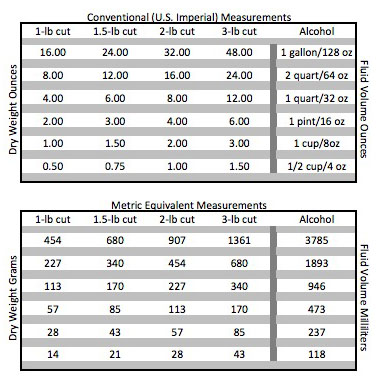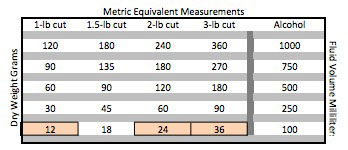
 by Steven D. Johnson
by Steven D. Johnson
Racine, Wisconsin
This month:
•
"Finishing" The Metric Conversion – Shellac Mixing The Metric Way
•
And Speaking Of "Mixing"...
•
Mobile Sanding Center – Design Criteria
•
Legendary Sharpening - No Skill Or Effort Required
•
Update...The Natural-Edge Coffee Table Project
"Finishing" The Metric Conversion
Remember when the rush was on to put an eleven-cent chip and LED readout into every conceivable appliance to tell us the time? In my kitchen the microwave, the stove, two coffee makers, and my refrigerator (for crying out loud!) show the time. Of course they are each different by a minute or two and I cringe when the power goes off forcing me to reset them all, but the real question all these digital displays raise is whether or not people in the future will know where the terms "clockwise" and "counter-clockwise" originated?
Woodworkers that routinely use shellac use the terms "two-pound cut" or "three-pound cut" to describe the dilution factor of shellac to alcohol. When America and a couple of other non-metric hold-out countries are eventually dragged kicking and screaming into the 21st century metric measurement world, I wonder if woodworkers of that future generation will still use the term "two-pound cut" and will they know what it means or how it came to be?
By the way, if you are not a devotee of shellac, you should try it. I am no finishing expert like Alan Noel...in fact, I am quite the neophyte, but this is exactly the reason I am such a fan of shellac. As a buddy told me years ago, "Once you shellac, you'll never go back!" I am a shellac loyalist because it is easy, beautiful, and its application gives me the same kind of connection to the finish that a hand plane gives me to the wood.
Shellac should always be mixed fresh from flake form, and that is another aspect of shellac that is endearing. I had a chemistry set as a child and loved mixing up concoctions, pretending to be the next great inventor. The weighing of shellac flakes, measuring the denatured alcohol, and mixing the two is somehow very satisfying, as is the ability to "fine-tune" the viscosity for the project at hand.
Historically woodworkers mix shellac in "pound-cut" ratios. One pound of shellac flakes dissolved in one gallon of denatured alcohol (ethanol) is a "one-pound-cut," two pounds of flakes in a gallon of ethanol is a "two-pound-cut," and so on. Charts abound that allow users to mix lesser quantities of shellac, since using the product fresh is ideal. It is easy to use the chart below to make as little as 1/2 cup (4 ounces) of shellac, a full gallon, or almost anything in-between. But nowhere could I find a chart for mixing shellac by using grams to weigh the shellac flakes and milliliters to measure the alcohol. So, for aspiring metric converts, I have created a metric equivalent chart:

|
|
Figure 1 - Click on the chart above to download a PDF version
|
Still, though, if we are to fully immerse ourselves (in the metric system, please, not in the shellac!) we need to do away with the one-pound, two-pound, three-pound cut nomenclature and come up with easy-to-remember metric names for our various dilution levels.
Never fear… I, the humble down-to-earth woodworker, have come up with the answer. Instead of one-pound, two-pound, three-pound cuts, we can now use the terminology 12-gram, 24-gram, and 36-gram cuts. See the following chart:

|
|
Figure 2 - Click on the chart above to download a PDF version
|
This is insanely easy. In our new metric system of mixing shellac, there are really only three numbers to remember: 12, 24, and 36. If you simply remember that to make a very light dilution of shellac (equivalent to our old "one-pound cut"), add 12 grams of shellac to 100 milliliters of alcohol. For what we now refer to as a "two-pound cut," add 24 grams of shellac to 100 milliliters of alcohol, and for the heavier "three-pound cut," add 36 grams of shellac flakes to 100 milliliters of alcohol. Any dilution ratio in between these numbers is also easy to calculate. Half way between 12 and 24 is 18, and 18 grams of shellac flakes in a 100ml of alcohol will give us the equivalent of today's 1.5-pound cut, but without a lot of calculation. It is easy, repeatable, and very accurate. It is also easily scalable.
Want to mix up a quantity not on the chart? Simply decide how much alcohol to start with, say 300 ml. 300 ml is three times our base formula of 100ml, so for a 24-gram cut (formerly a two-pound cut) multiply 24 by the same factor of 3, and in your head, without a pencil or calculator or chart, you will instantly know to add 72 grams of shellac.
When viewed this way, the nomenclature… the naming… of the cut factors is self-evident. Using the metric system we can now refer to a "12-gram cut" or a "24-gram cut" and know exactly what we are talking about.
(Page 1 of 5)
1
2
3
4
5
Next Page
Return to Wood News front page
